Mathematical Modeling of the Coaxial Quadrotor Dynamics for Its Attitude and Altitude Control
Abstract
1. Introduction
2. Coaxial Quadrotor Control Basics
2.1. Physical Construction of Coaxial Quadrotor
2.2. Change of the UAV’s Position and Orientation
3. The Coaxial Quadrotor Model
3.1. Euler Angles
- Rotation Yaw about angle in the z axis of the (global coordinate system),
- Rotation Pitch about angle in the y axis of the (new coordinate system),
- Rotation Roll about angle in the x axis of the (new local coordinate system), yielding as a product.
3.2. Angular Velocities
3.3. Angular Acceleration
3.3.1. Input Torques
3.3.2. Gyroscopic Effect
3.3.3. Viscous Friction
3.3.4. Drag-Like Effects
3.3.5. Orientation Model—Angular Acceleration
3.4. Linear Acceleration
3.4.1. Thrust Force
3.4.2. Gravitational Force
3.4.3. Coriolis Force
3.4.4. Drag Forces
3.4.5. Friction in Linear Motion
3.4.6. Linear Motion Model—Linear Acceleration
4. Model Validation
4.1. Introduction
- the total mass of the flying robot (m),
- the mass of the individual propulsion unit (),
- the arm’s length in the robot cross frame (l),
- the distance between propeller’s plane and the arm in respect to the Z axis of the (h),
- moments of inertia in X, Y, Z axes, respectively: , , , , , , ,
- coefficients (, , , , , ) used in input torques, viscous friction and drag effects models.
- Simultaneous search for controller gains for orientation in the axes: X, Y and Z, where the minimized cost function is defined as a sum of squared errors between the set and obtained angle (note that ),
- Search for the Z-axis position controller gains. The minimized cost function is a sum of squared errors between the set and measured altitude.
- Search for the position controller gains in the X and Y axes, the minimized cost function is a sum of squared errors between the set and measured position.
4.2. Experiment No. 1
4.3. Experiment No. 2
4.4. Experiment No. 3 (with Real-World Data from the Falcon V5 Flying Robot)
5. Summary
Supplementary Materials
Author Contributions
Funding
Institutional Review Board Statement
Informed Consent Statement
Data Availability Statement
Acknowledgments
Conflicts of Interest
Abbreviations
| BLDC | Brushless Direct Current Electric Motor |
| CCW | Counter-Clockwise |
| CFRP | Carbon Fiber Reinforced Polymer |
| CW | Clockwise |
| DOF | Degree of Freedom |
| ESC | Electronic Speed Controller |
| IMU | Inertial Measurement Unit |
| LQR | Linear-Quadratic Regulator |
| NED | North-East-Down |
| PD | Proportional–Derivative Controller |
| PID | Proportional–Integral–Derivative Controller |
| PSO | Particle Swarm Optimization |
| PWM | Pulse-Width Modulation |
| UAV | Unmanned Aerial Vehicle |
Appendix A
References
- Haddadi, S.-J.; Zarafshan, P. Attitude control of an autonomous octorotor. In Proceedings of the 2014 Second RSI/ISM International Conference on Robotics and Mechatronics (ICRoM), Tehran, Iran, 15–17 October 2014; pp. 540–545. [Google Scholar]
- Raharja, G.; Kwangjoon, Y. Design and implementation of coaxial quadrotor for an autonomous outdoor flight. In Proceedings of the 2011 8th International Conference on Ubiquitous Robots and Ambient Intelligence (URAI), Incheon, Korea, 23–26 November 2011; pp. 61–63. [Google Scholar]
- Kim, G.; Nguyen, T.; Budiyono, A. Design and Development of a Class of Rotorcraft-based UAV. J. Adv. Robot. Syst. 2013, 131, 1–9. [Google Scholar] [CrossRef]
- Bermes, C. Design and Dynamic Modeling of Autonomous Coaxial Micro Helicopters. Ph.D. Thesis, ETH Zurich, Zurich, Switzerland, 2010. [Google Scholar]
- Liu, H.; Wang, X.; Zhong, Y. Quaternion-based robust attitude control for uncertain robotic quadrotors. IEEE Trans. Ind. Inform. 2015, 11, 406–415. [Google Scholar] [CrossRef]
- Huang, H.; Hoffmann, G.; Waslander, S. Aerodynamics and control of autonomous quadrotor helicopters in aggressive maneuvering. In Proceedings of the 2009 IEEE International Conference on Robotics and Automation, Kobe, Japan, 12–17 May 2009; pp. 3277–3282. [Google Scholar]
- Lei, Y.; Bai, Y.; Xu, Z. An experimental investigation on aerodynamic performance of a coaxial rotor system with different rotor spacing and wind speed. Exp. Therm. Fluid Sci. 2013, 44, 779–785. [Google Scholar] [CrossRef]
- Sharf, I.; Nahon, M.; Harmat, A. Ground effect experiments and model validation with draganflyer rotorcraft. In Proceedings of the 2014 International Conference on Unmanned Aircraft Systems (ICUAS), Orlando, FL, USA, 27–30 May 2014; pp. 1158–1166. [Google Scholar]
- Cho, S.H.; Bhandari, S.; Cheung, K.K.; Tischler, M.B. System Identification and Controller Optimization of a Coaxial Quadrotor UAV in Hover. In Proceedings of the AIAA Scitech 2019 Forum, San Diego, CA, USA, 7–11 January 2019; pp. 1–14. [Google Scholar]
- Tsadok, T. Thruster Modeling for Small Unmanned Aerial Vehicles with Coaxial-Rotors. Ph.D. Thesis, McGill University, Montreal, QC, Canada, 2014. [Google Scholar]
- Clark, A.; Walker, M. Quadrotor Aerodynamic Test; Technical Report UW 1961; Aeronautical Laboratory, University of Washington: Seattle, WA, USA, 2010. [Google Scholar]
- Wei, P.; Yang, Z.; Wang, Q. The design of quadcopter frame based on finite element analysis. In Proceedings of the 3rd International Conference on Mechatronics, Robotics and Automation (ICMRA), Shenzhen, China, 20–21 April 2015; pp. 1353–1356. [Google Scholar]
- Zhang, D.; Qi, H.; Wu, T. The quadrotor dynamic modeling and indoor target tracking control method. Math. Probl. Eng. 2014, 1, 1–9. [Google Scholar] [CrossRef]
- Kuric, M.; Osmic, N.; Tahirovic, A. Multirotor Aerial Vehicle modeling in Modelica. In Proceedings of the 12th International Modelica Conference, Prague, Czech Republic, 15–17 May 2017; pp. 373–380. [Google Scholar]
- Chen, Z.; Peng, Z.; Zhang, F. Attitude control of coaxial tri-rotor UAV based on linear extended state observer. In Proceedings of the 26th Chinese Control and Decision Conference (CCDC), Changsha, China,, 31 May–2 June 2014; pp. 4204–4209. [Google Scholar]
- Liu, W.; Huo, X.; Liu, J.; Wang, L. Parameter Identification for a Quadrotor Helicopter Using Multivariable Extremum Seeking Algorithm. Int. J. Control. Autom. Syst. 2018, 16, 1951–1961. [Google Scholar] [CrossRef]
- Tofigh, M.A.; Mahjoob, M.J.; Ayati, M. Dynamic modeling and nonlinear tracking control of a novel modified quadrotor. Int. J. Robust Nonlinear Control. 2018, 28, 552–567. [Google Scholar] [CrossRef]
- Jeong, H.; Hwang, M.; Jung, H. Mathematical modeling of a multilayered drift-stabilization method for micro-UAVs using inertial navigation unit sensor. J. Appl. Math. 2014, 1, 1–11. [Google Scholar] [CrossRef]
- Subudhi, C.S.; Ezhilarasi, D. Modeling and Trajectory Tracking with Cascaded PD Controller for Quadrotor. Procedia Comput. Sci. 2018, 133, 952–959. [Google Scholar] [CrossRef]
- Elkholy, H. Dynamic Modeling and Control Techniques for a Quadrotor; IGI Global Publisher: Hershey, PA, USA, 2019. [Google Scholar]
- Bouadi, H.; Mora-Camino, F. Modeling and Adaptive Flight Control for Quadrotor Trajectory Tracking. J. Aircr. 2018, 55, 666–681. [Google Scholar] [CrossRef]
- Bodo, S.; Lantos, B. Modeling and Control of Outdoor Quadrotor UAVs. In Proceedings of the IEEE 16th International Symposium on Intelligent Systems and Informatics, Subotica, Serbia, 13–15 September 2018; pp. 111–116. [Google Scholar]
- Saied, M.; Shraim, H.; Lussier, B.; Fantoni, I.; Francis, C. Local Controllability and Attitude Stabilization of multirotor UAVs: Validation on a coaxial Octorotor. RObotics Auton. Syst. 2017, 91, 128–138. [Google Scholar] [CrossRef]
- Gautam, D.; Ha, C. Control of a quadrotor using a smart self-tuning fuzzy PID controller. J. Adv. Robot. Syst. 2013, 10, 1–9. [Google Scholar] [CrossRef]
- Kurak, S.; Hodzic, M. Control and Estimation of a Quadcopter Dynamical Model. Period. Eng. Nat. Sci. 2018, 6, 63–75. [Google Scholar] [CrossRef]
- Grau, A.; Bolea, Y.; Sanfeliu, A. Quadrotor Multi-model for Control Purposes. Int. Conf. Math. Model. Phys. Sci. 2018, 1141, 1–6. [Google Scholar] [CrossRef]
- Lee, H.; Kim, H.J. Trajectory tracking control of multirotors from modelling to experiments: A survey. Int. J. Control. Autom. Syst. 2017, 15, 281–292. [Google Scholar] [CrossRef]
- Nascimento, T.P.; Saska, M. Position and attitude control of multi-rotor aerial vehicles: A survey. Annu. Rev. Control 2019, 48, 129–146. [Google Scholar] [CrossRef]
- Goslinski, J.; Giernacki, W.; Gardecki, S. An efficient PSO-based method for an identification of a quadrotor model parameters. Adv. Intell. Syst. Comput. 2015, 351, 95–104. [Google Scholar]
- Szafranski, G.; Czyba, R.; Blachuta, M. Modeling and identification of electric propulsion system for multirotor unmanned aerial vehicle design. In Proceedings of the 2014 International Conference on Unmanned Aircraft Systems, Orlando, FL, USA, 27–30 May 2014; pp. 470–476. [Google Scholar]
- Goslinski, J.; Giernacki, W.; Kasinski, A.; Owczarek, P.; Gardecki, S. A study on coaxial quadrotor model identification and parameter estimation: The improved square root unscented Kalman filter. J. Intell. Robot. Syst. 2019, 95, 491–510. [Google Scholar] [CrossRef]
- Njinwoua, B.J.; Wouwer, A.V. Cascade attitude control of a quadcopter in presence of motor asymmetry. Sci. Ifac Pap. 2018, 51, 113–118. [Google Scholar]
- Hermand, E.; Nquyen, T.W.; Hosseinzadeh, M.; Garone, E. Constrained Control of UAVs in Geofencing Applications. In Proceedings of the 26th Mediterranean Conference on Control and Automation (MED), Zadar, Croatia, 19–22 June 2018; pp. 217–222. [Google Scholar]
- Craig, J.; Walker, M. Introduction to Robotics: Mechanics and Control; Pearson Education International: London, UK, 2005. [Google Scholar]
- Goldstein, H.; Poole, C.; Safko, J. Classical Mechanics, 3rd ed.; Addison Wesley: Reading, MA, USA, 2005. [Google Scholar]
- Olsson, H.; Astrom, K.; Wit, C.; Gfvert, M.; Lischinsky, P. Friction models and friction compensation. Eur. J. Control 1998, 4, 176–195. [Google Scholar] [CrossRef]
- Bangura, M.; Mahony, R. Nonlinear dynamic modeling for high performance control of a quadrotor. In Proceedings of the Australasian Conference on Robotics and Automation, Victoria University of Wellington, Wellington, New Zealand, 3–5 December 2012; pp. 1–9. [Google Scholar]
- Mahony, R.; Kumar, V.; Corke, P. Multirotor aerial vehicles: Modeling, estimation and control of quadrotor. IEEE Robot. Autom. Mag. 2012, 19, 20–32. [Google Scholar] [CrossRef]
- Leishman, J.G. Principles of Helicopter Aerodynamics; Cambridge Aerospace Series; Cambridge Aerospace: Cambridge, MA, USA, 2002. [Google Scholar]
- Bangura, M. Aerodynamics and Control of Quadrotors. Ph.D. Thesis, The Australian National University, Canberra, Australia, 2017. [Google Scholar]
- Bondyra, A.; Gardecki, S.; Gasior, P.; Giernacki, W. Performance of coaxial propulsion in design of multi-rotor UAVs. Adv. Intell. Syst. Comput. 2016, 440, 523–531. [Google Scholar]
- Kennedy, J.; Eberhart, R. Particle swarm optimization. J. Appl. Math. 1995, 1, 1–11. [Google Scholar]
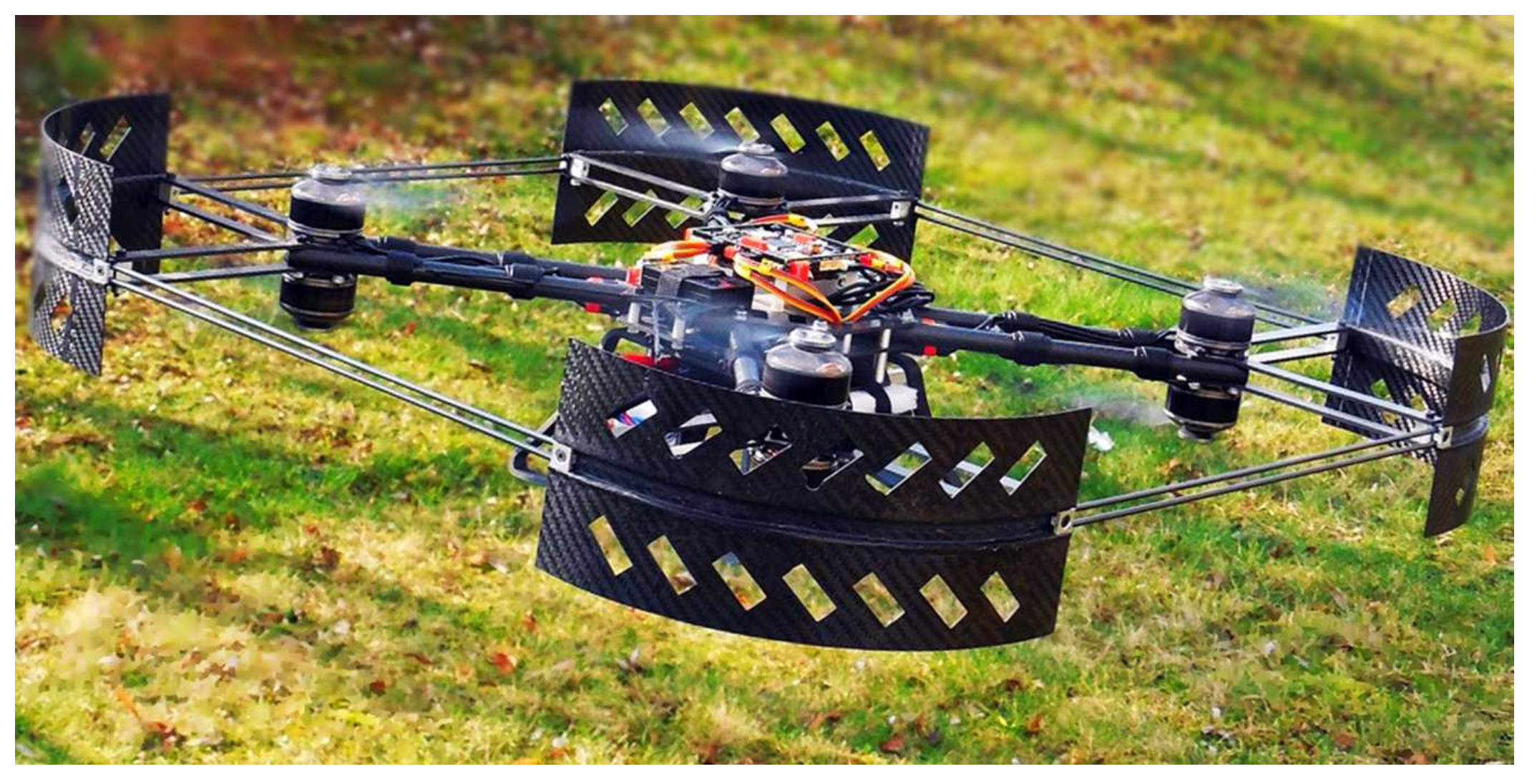
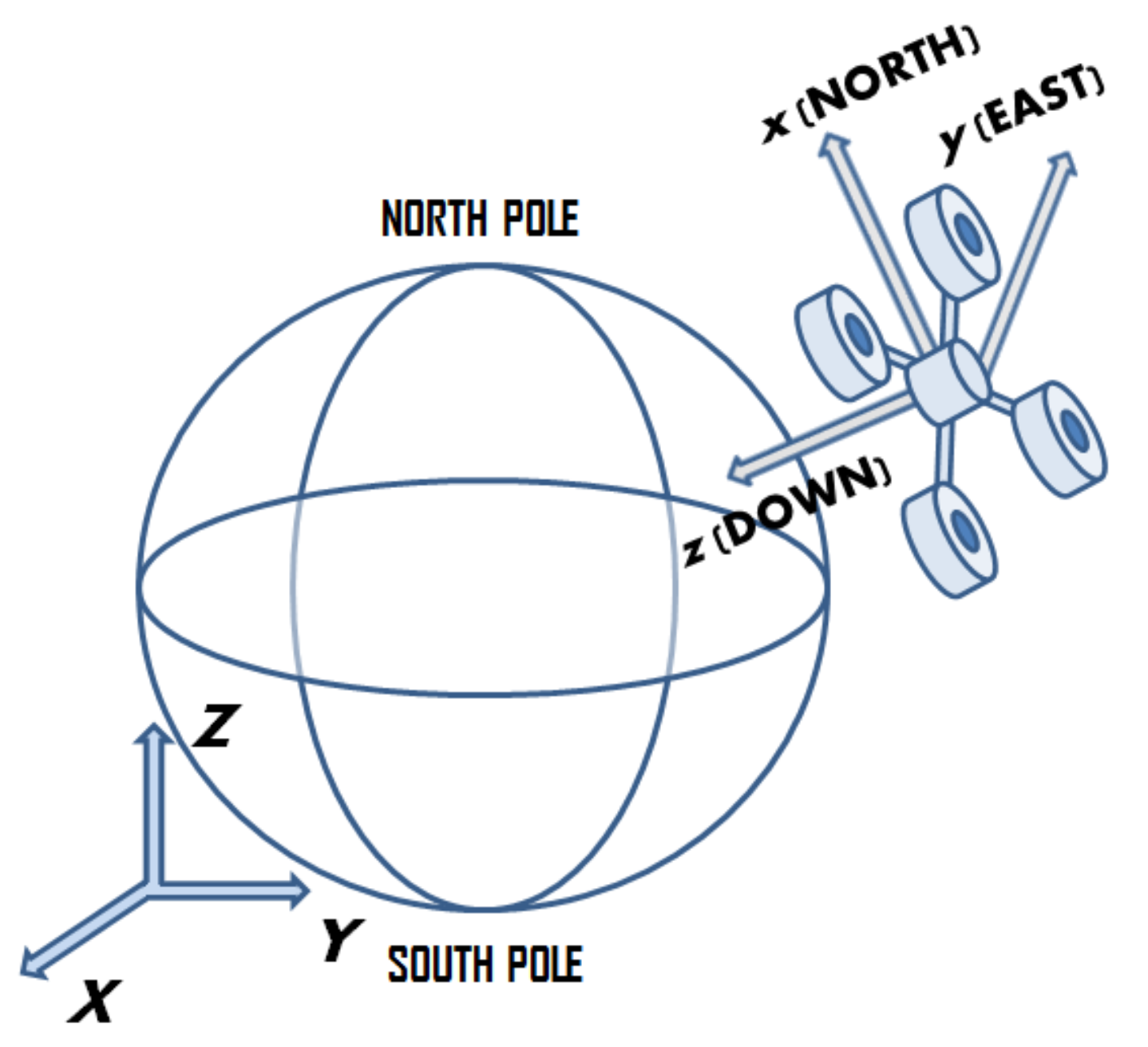
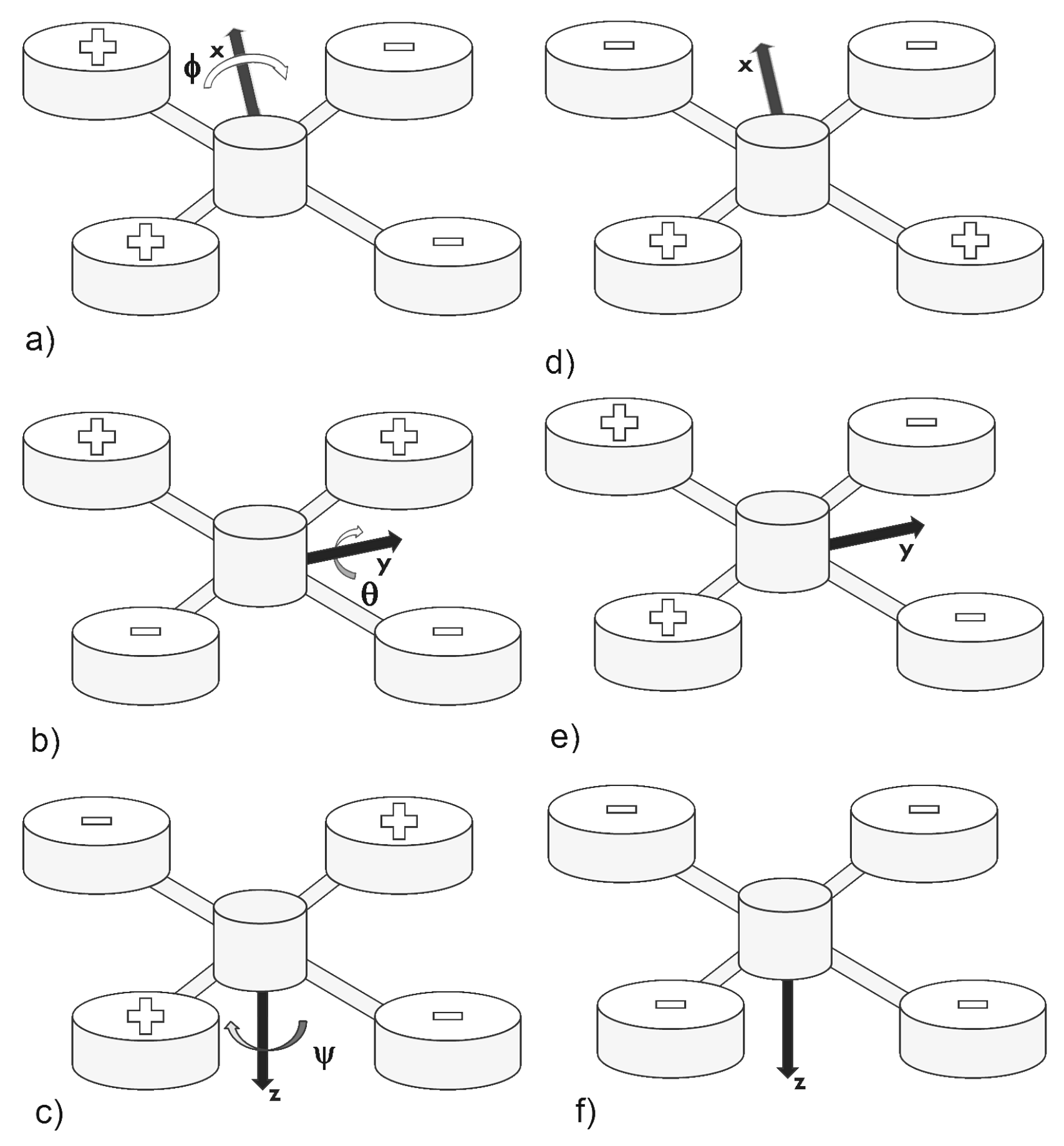
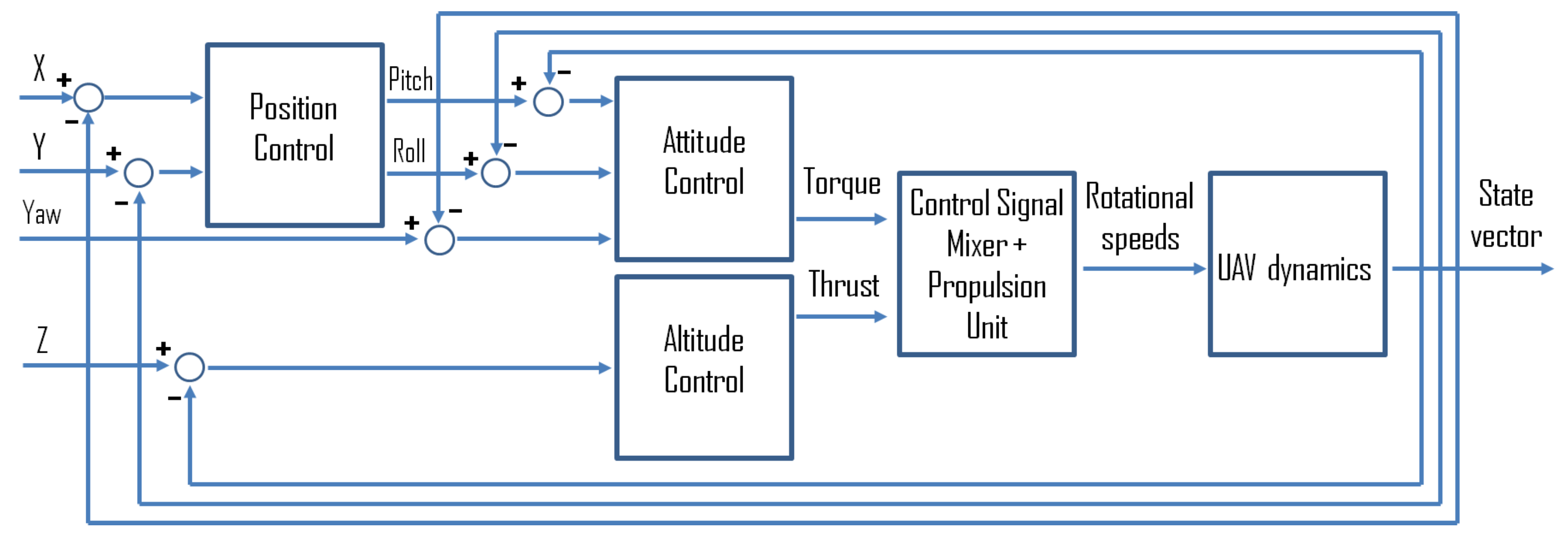
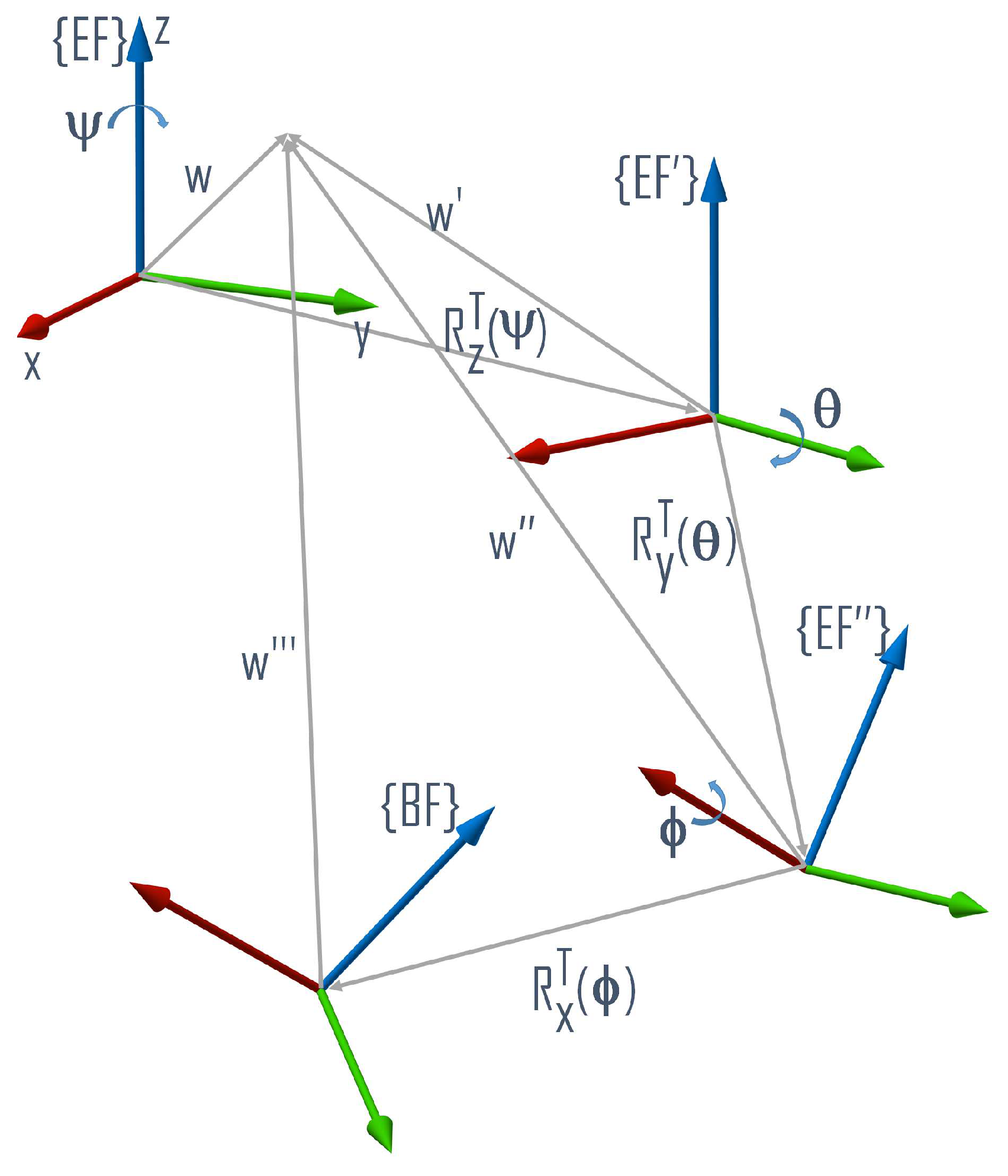
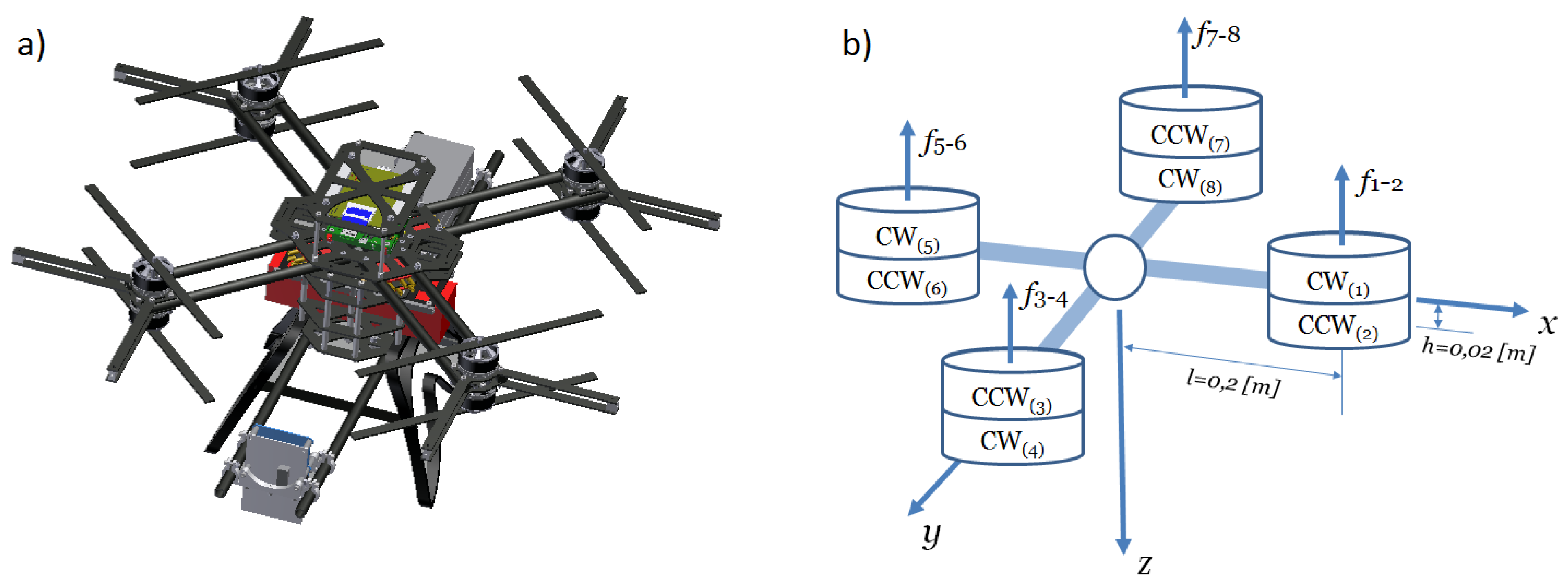

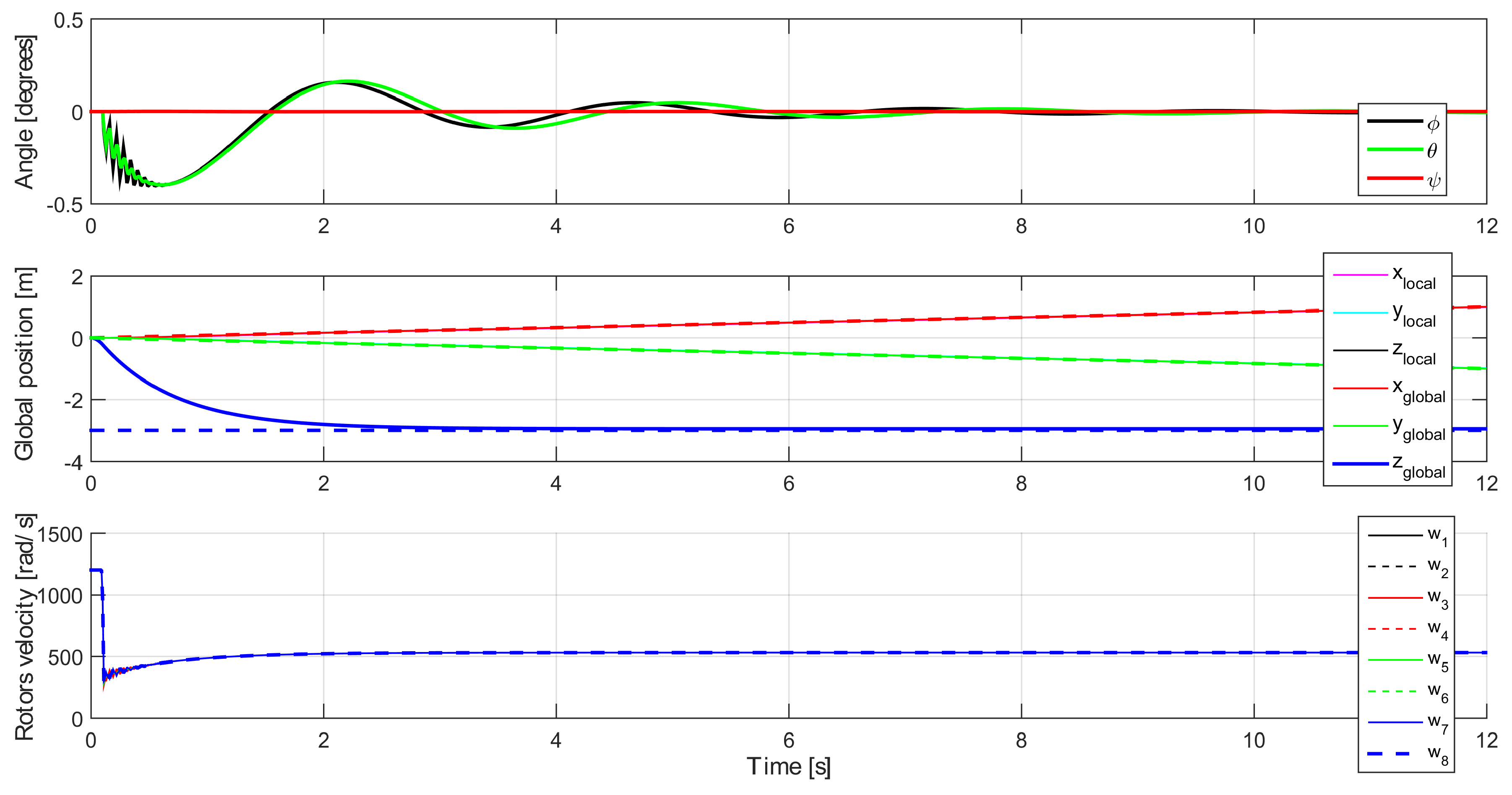

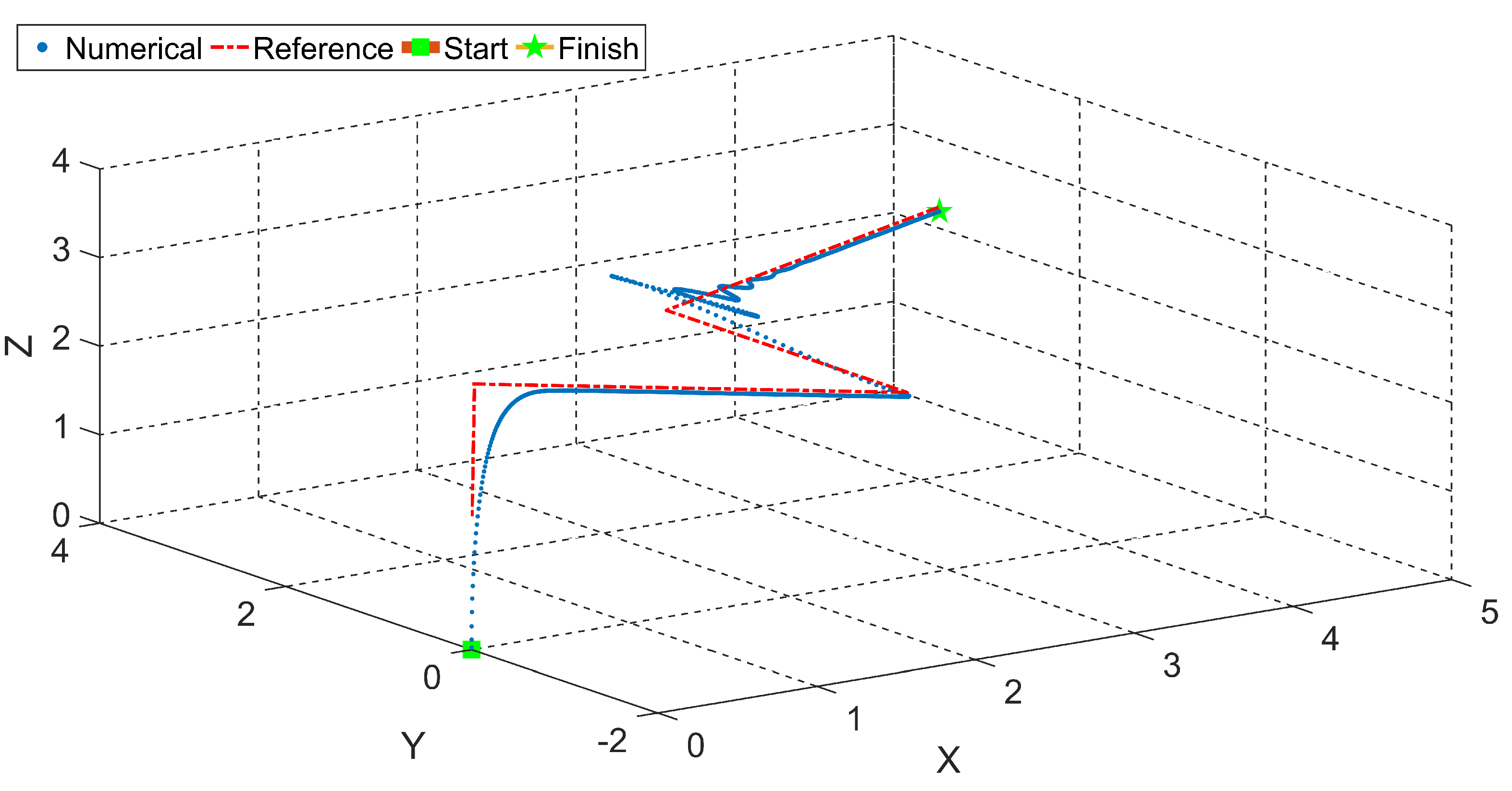
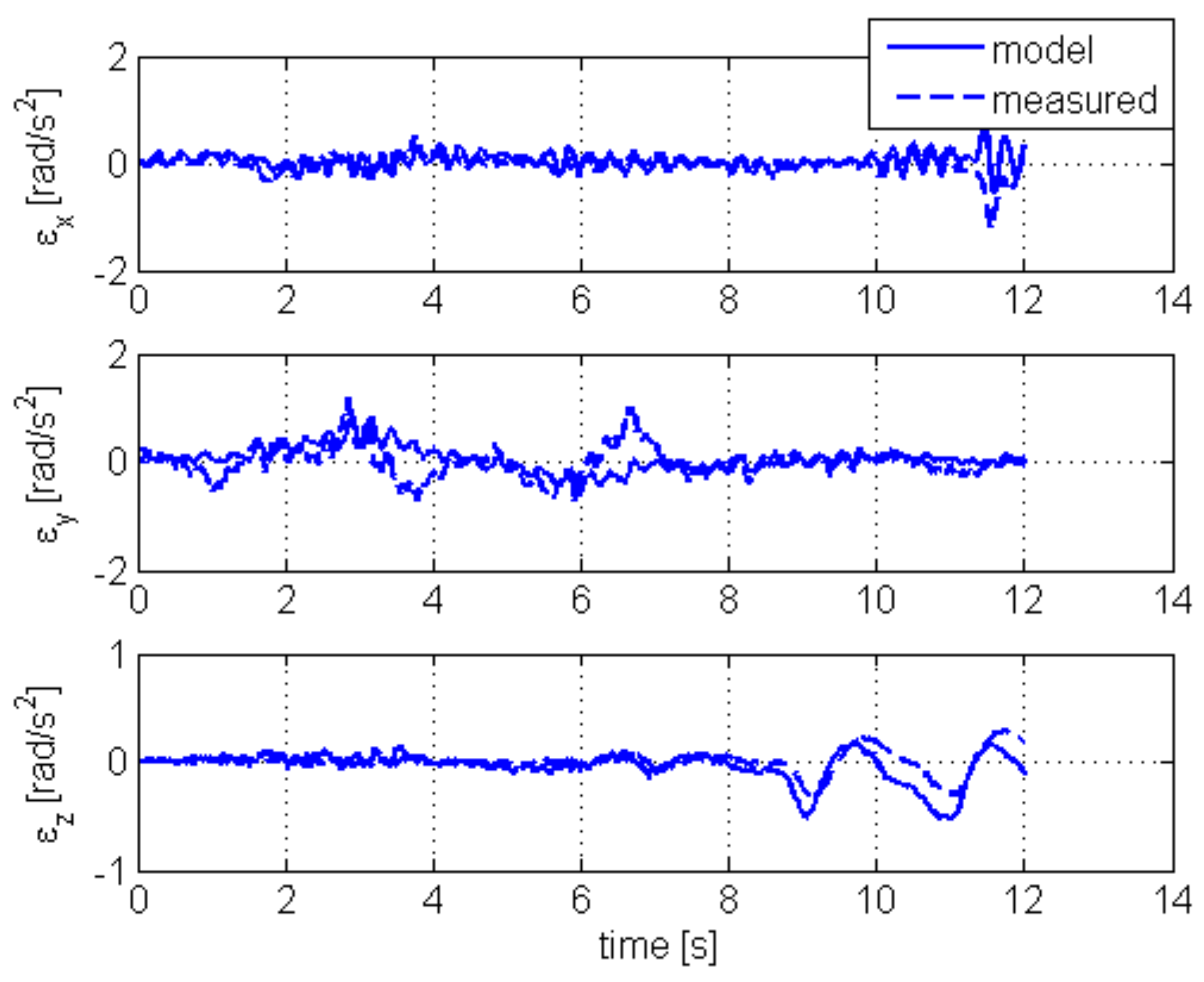
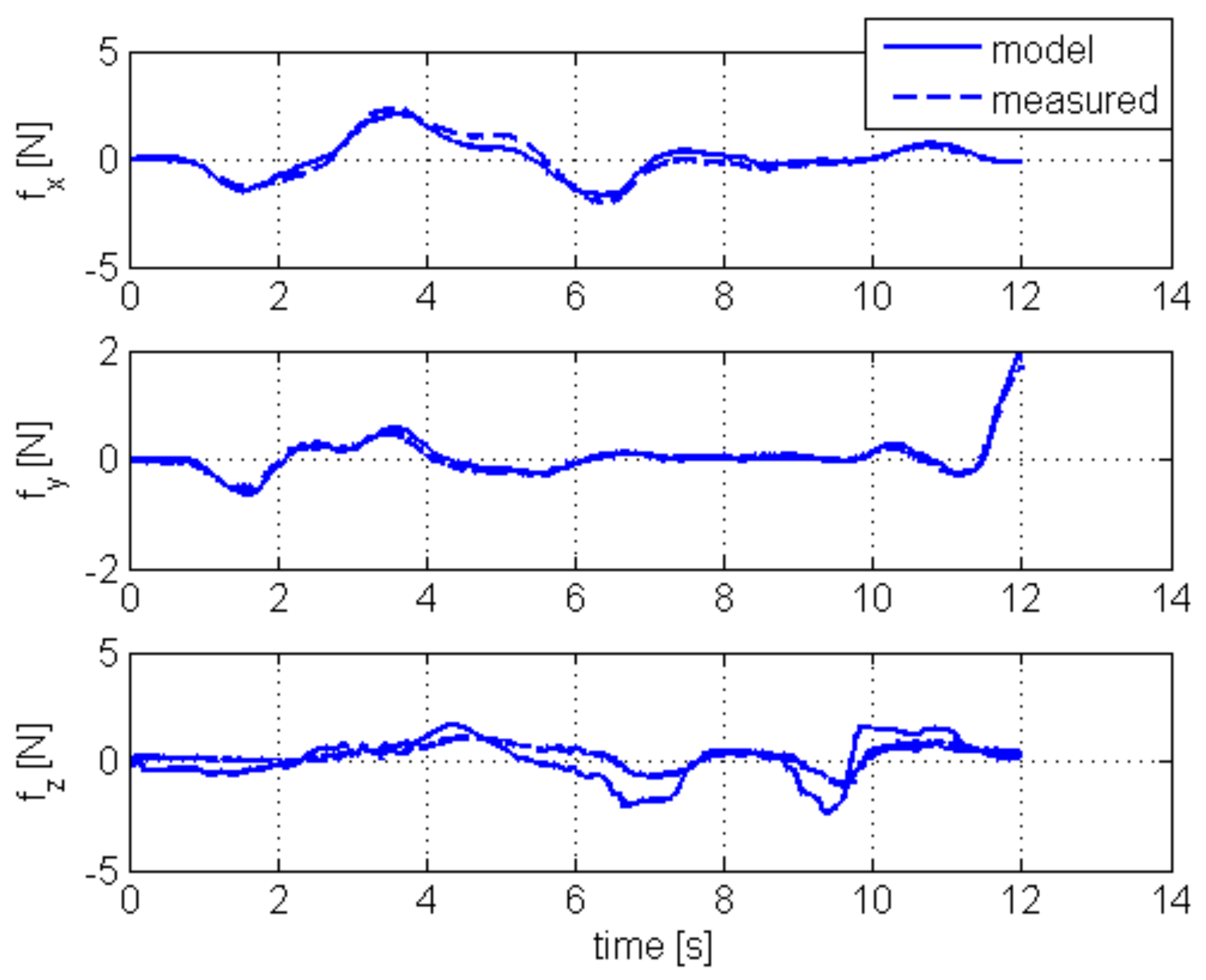
Publisher’s Note: MDPI stays neutral with regard to jurisdictional claims in published maps and institutional affiliations. |
© 2021 by the authors. Licensee MDPI, Basel, Switzerland. This article is an open access article distributed under the terms and conditions of the Creative Commons Attribution (CC BY) license (http://creativecommons.org/licenses/by/4.0/).
Share and Cite
Giernacki, W.; Gośliński, J.; Goślińska, J.; Espinoza-Fraire, T.; Rao, J. Mathematical Modeling of the Coaxial Quadrotor Dynamics for Its Attitude and Altitude Control. Energies 2021, 14, 1232. https://doi.org/10.3390/en14051232
Giernacki W, Gośliński J, Goślińska J, Espinoza-Fraire T, Rao J. Mathematical Modeling of the Coaxial Quadrotor Dynamics for Its Attitude and Altitude Control. Energies. 2021; 14(5):1232. https://doi.org/10.3390/en14051232
Chicago/Turabian StyleGiernacki, Wojciech, Jarosław Gośliński, Jagoda Goślińska, Tadeo Espinoza-Fraire, and Jinjun Rao. 2021. "Mathematical Modeling of the Coaxial Quadrotor Dynamics for Its Attitude and Altitude Control" Energies 14, no. 5: 1232. https://doi.org/10.3390/en14051232
APA StyleGiernacki, W., Gośliński, J., Goślińska, J., Espinoza-Fraire, T., & Rao, J. (2021). Mathematical Modeling of the Coaxial Quadrotor Dynamics for Its Attitude and Altitude Control. Energies, 14(5), 1232. https://doi.org/10.3390/en14051232







